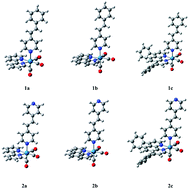The mechanism of photoisomerization of stilbene-like ligands coordinated to rhenium polypyridine or α-diimine carbonyls is deciphered in the light of recent theoretical results obtained at various levels of theory, density functional theory (DFT, time-dependent DFT) and state-of-the-art ab initio methods, complete active space self-consistent field (CASSCF) and multi-state CAS perturbation theory 2nd Order (MS-CASPT2). On the basis of the electronic absorption spectra and potential energy profiles (PEF) associated to the low-lying singlet and triplet intra-ligand (IL) and metal-to-ligand-charge-transfer (MLCT) excited states, coupled by spin–orbit interactions and calculated for the series [Re(CO)3(N,N)(L)]+ with N,N = bpy, phen and ph2phen (bpy = 2,2′-bipyridine; phen = 1,10-phenanthroline; ph2phen = 4,7-diphenyl-1,10-phenanthroline) and L = stpy or bpe (stpy = 4-styrylpyridine; bpe = 1,2-bis(4-pyridylethylene) it is shown that the dynamics of the isomerization process are controlled by several features: (i) the occurrence of a 1ILL/1MLCTNN conical intersection in the vicinity of the 1MLCTNN absorption domain (ii) the kinetics of 1MLCTNN/3MLCTNN intersystem crossings; (iii) the kinetics of 3MLCTNN/3ILL internal conversion. The branching ratio between the two main isomerization pathways, namely along the 1ILL PEF via1MLCTNN/1ILL internal conversion at the conical intersection or along the 3ILL PEF after 3MLCTNN/3ILL charge transfer is largely influenced by the nature of the N,N antenna and L isomerizable ligands.

You have access to this article
 Please wait while we load your content...
Something went wrong. Try again?
Please wait while we load your content...
Something went wrong. Try again?


 Please wait while we load your content...
Please wait while we load your content...